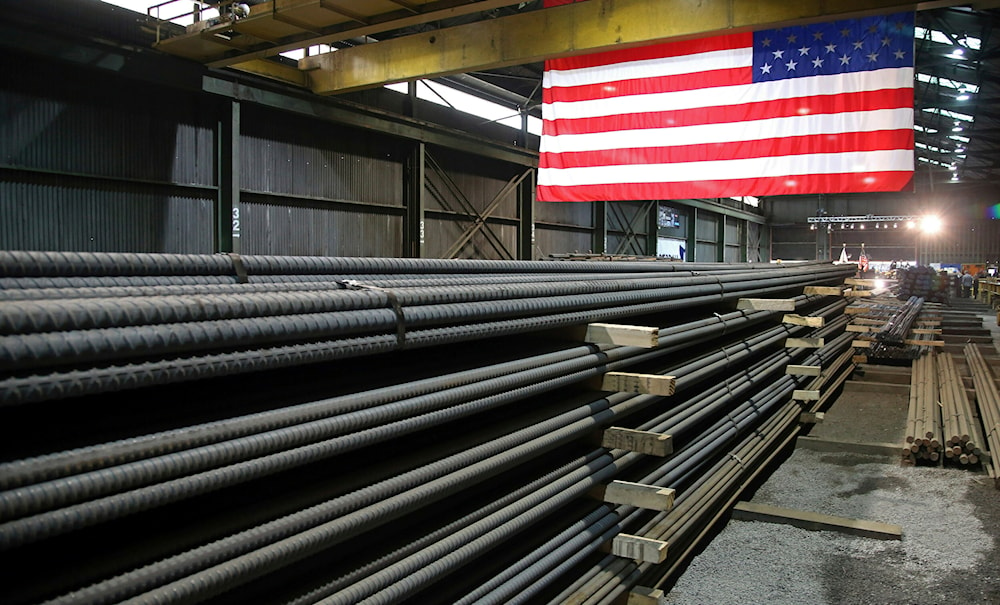US 25% tariffs on steel, aluminum imports in force; EU hits back
President Donald Trump’s decision to impose 25 percent tariffs on both metals is expected to increase production costs for various goods, including home appliances, automobiles, and beverage cans.
-

In this May 9, 2019, photo, steel rods produced at the Gerdau Ameristeel mill in St. Paul, Minn. await shipment. (AP)
The United States expanded its range of tariffs on Wednesday as broad duties on steel and aluminum imports came into force "with no exceptions or exemptions," as pledged by the White House—despite multiple countries’ efforts to avoid them.
President Donald Trump’s decision to impose 25% tariffs on both metals is expected to increase production costs for various goods, including home appliances, automobiles, and beverage cans, potentially driving up consumer prices.
"It wouldn’t surprise me to see the tariffs pretty quickly show up in prices," Cato Institute research fellow Clark Packard told AFP. He noted that the auto and construction industries—covering both residential and commercial sectors—are among the largest consumers of steel in the United States.
Since returning to office, Trump has imposed significant tariffs on key US trading partners, including Canada, Mexico, and China. While he permitted a partial rollback for Canada and Mexico, he has also vowed to introduce additional duties beginning April 2.
The latest round of tariffs will again hit Canada particularly hard, as it supplies around 50% of US aluminum imports and 20% of its steel, according to an analysis by EY chief economist Gregory Daco. Other major steel exporters to the US include Brazil and Mexico, while the United Arab Emirates and South Korea are key aluminum suppliers.
With these new duties stacking atop previous tariffs, some steel and aluminum imports from Canada and Mexico could now face a 50% tariff unless they comply with the US-Mexico-Canada Agreement (USMCA).
Market volatility and Trump’s response
Uncertainty surrounding Trump’s trade policies and concerns that they could push the US into a recession have unsettled financial markets. Wall Street saw a second consecutive day of losses on Tuesday.
However, Trump dismissed concerns about his economic strategy, stating on Tuesday that he does not anticipate a downturn and downplaying the market declines. Trump’s trade policies have been marked by unpredictability. Less than 24 hours before the new tariffs took effect, he threatened to double the rate on Canadian steel and aluminum to 50%.
The move followed Canada’s Ontario province announcing an electricity surcharge on three US states in retaliation for earlier American tariffs. Trump reacted angrily, escalating tensions by suggesting plans to annex Canada.
The dispute led to a heated exchange of tariff threats between Washington and Ottawa. However, Ontario ultimately suspended the surcharge after negotiations with the US.
White House spokesperson Kush Desai said Trump "used the leverage of the American economy" to "deliver a win for the American people."
Ontario Premier Doug Ford, US Commerce Secretary Howard Lutnick, and US Trade Representative Jamieson Greer are scheduled to meet in Washington on Thursday to discuss the "renewed USMCA ahead of the April 2 reciprocal tariff deadline," according to a joint US-Canada statement.
When asked about Trump’s shifting tariff policies, White House senior counselor Peter Navarro characterized the process as "a negotiation".
"It is a transition," he said. "It’s going to be at times, perhaps a little bumpy."
Widespread uncertainty
Even before the latest tariffs were implemented, manufacturers had been scrambling to secure cost-effective domestic suppliers.
Packard noted that "the mere threat of protectionism" has already allowed US steel and aluminum companies to hike their prices, creating "massive amounts of uncertainty."
While some American manufacturers who use domestically produced steel see the tariffs as beneficial to their business, others warn that they merely increase import costs while making US-made products equally expensive.
Daco of EY highlighted that these new tariffs go beyond those imposed by Trump in 2018, now covering a broader range of finished products in addition to raw steel and aluminum.
Furthermore, the higher aluminum tariff rates, coupled with existing trade restrictions, "are likely to make foreign sourcing more expensive across multiple industries."
Despite recent visits to Washington by officials from Australia and Japan seeking exemptions, the US government has not granted any exclusions.
Australian Prime Minister Anthony Albanese called the tariffs "entirely unjustified" but stated that his country would not retaliate.
It remains unclear whether Trump will eventually offer relief to some nations or negotiate separate trade agreements, as he did during his first administration.
Looking ahead, Trump has pledged to introduce additional reciprocal tariffs as early as April 2 to address what Washington considers unfair trade practices—raising the prospect of further restrictions on specific goods and trading partners.
EU strikes back with counter tariffs
The European Union announced on Wednesday that it will impose counter-tariffs on US goods worth 26 billion euros ($28.33 billion) starting next month, in retaliation to US tariffs on steel and aluminum. The European Commission stated that the suspension of tariffs on US products will end on April 1, and a new package of countermeasures will be introduced by mid-April.
"This matches the economic scope of the U.S. tariffs. Our countermeasures will be introduced in two steps. Starting with 1 April and fully in place as of 13 April," European Commission President Ursula von der Leyen said in a statement.
"We are ready to engage in meaningful dialogue. I have entrusted Trade Commissioner Maros Sefcovic to resume his talks to explore better solutions with the U.S.," von der Leyen added.
"As of this morning the United States is applying a 25% tariff on imports of steel and aluminium. We deeply regret this measure. Tariffs are taxes. They are bad for business, and even worse for consumers. These tariffs are disrupting supply chains ... The European Union must act to protect consumers and business. The countermeasures we take today are strong but proportionate. As the US are applying tariffs worth 28 billion dollars, we are responding with countermeasures worth €26 billion," von der Leyen stressed in a statement.
Brussels unveils retaliatory tariffs on $20 billion US goods
The European Commission also issued a statement announcing retaliatory measures targeting US goods worth approximately 18 billion euros ($19.6 billion), set to take effect in mid-April.
"On 12 March, the United States imposed tariffs of up to 25% on imports of steel, aluminium, and certain products containing steel and aluminium from the European Union and other trading partners. In response, the Commission is launching a series of countermeasures to protect European businesses, workers, and consumers from the impact of these unjustified trade restrictions," the EU body said in a statement.
Starting April 1, the EU will reinstate the rebalancing measures from 2018 and 2020, and a new package of countermeasures will be implemented in mid-April.
"Since the new US tariffs are significantly broader in scope and affect a significantly higher value of European trade, the Commission launched on 12 March the process to impose additional countermeasures on the US. These will target approximately €18 billion worth of goods, which will then apply together with the reimposed measures from 2018," the Commission added.

 7 Min Read
7 Min Read








